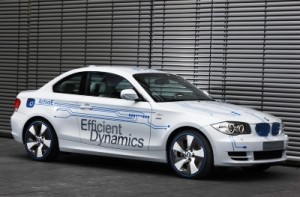Debuting at the North American International Auto Show in Detroit next month will be an electric version of BMW’s small four-seat coupe, Concept ActiveE.
The Bavarian company known for its performance sedans says the coupe is capable of acceleration from zero-to-100 km/h (62 mph) in less than 9 seconds, with a maximum speed of about 145 km/h (90 mph, electronically limited.
The motor, specially developed for the model and located in the rear axle, delivers 125 kW or 170 horsepower and provides maximum torque of 250 Nm or 184 lb-ft.
The real-world range world range of the EV is expected to be about 160 km (100 miles) on a single charge, depending on your weather conditions, and your lead foot. (Well, maybe it should be “lithium foot” these days.)
The FTP 72 cycle range (Federal Test Procedure) is calculated to be 240 km (150 miles) in simulation, according to BMW. The cycle, which is stop and go, favors an electric vehicle since simulates an urban route of 7.5 miles with frequent stops. The maximum speed is 56.7 mph and the average speed is 19.6 mph – not exactly autobahn usage figures.
It was the use of numbers derived like these that caused the hybrid mileage controversy when real results turned out much lower. Honda recently settled a class-action suit over such a matter. BMW is to be commended for its honest, data-based approach here.
The Bimmer, like most other EVs under development, has a lithium-ion battery pack. In this case developed jointly by BMW and partner SB LiMotive, itself a Korean (Samsung) and German (Bosch) joint venture. One crucial piece of data missing, tough, is how many kilowatt hours of capacity the battery has since it currently costs between $800- $1,000 per kWh for a lithium battery. As a guess, I speculate that the battery pack is between 15-20 kWh in size, or ~$15,000 in cost.
BMW says that technology enables the lithium-ion battery pack to be recharged by a conventional power outlet at public charging stations or at a special wall box. On the European grid, the battery pack can be fully charged at a high-current power outlet (50 ampere) in as little as 3 hours. In North America, using a high-current (32 ampere continuous) residential wall box, the charge time is about 4.5 hours.
The largest portion of the battery pack in the Concept ActiveE is located where the conventional driveshaft and fuel tank would be in the lower part of the car. A portion of the battery pack is in the former engine compartment. BMW claims a lightweight design. However, vehicle curb weight is about 1800 kg or 3,900 pounds.
Field tests of the companion Mini E are already underway as part of project i (sic) in the U.S. and Europe. About 600 were made and they are being used by private customers in California, New York and New Jersey, and several European locations.
Project i will now begin development of a second trial fleet of electric vehicles based on the BMW Concept ActiveE. The end game is an electrically-powered serial production vehicle, which the BMW Group will put on the market under a sub-brand of BMW in the first half of the next decade.

